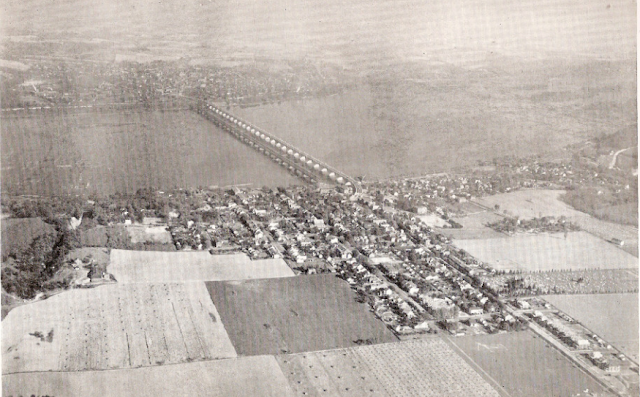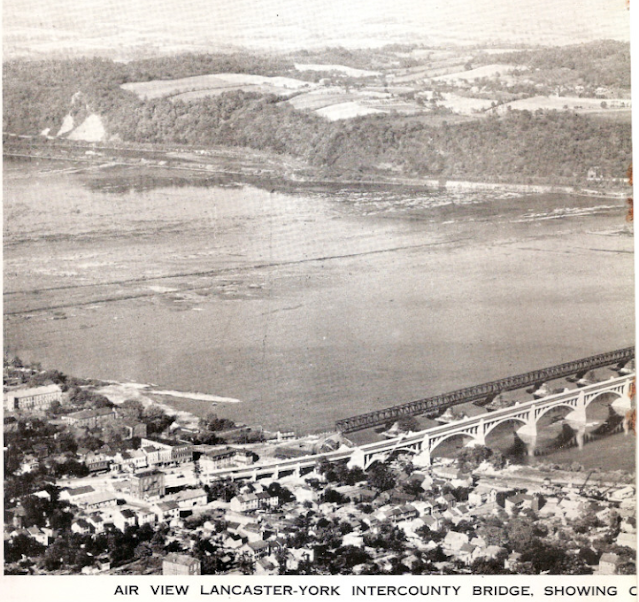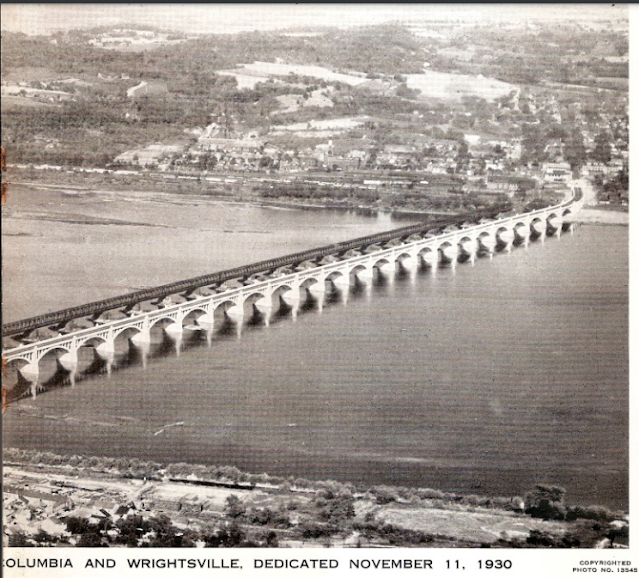1896: (Archived Bridge Hunter;)
Abandoned Piers for lost 1896-1964 Pennsy bridge: (Archived Bridge Hunter; Satellite)
1972 Wrights Ferry: (Satellite)
 |
| HAER PA,36-COL,1--14 (CT) 3/4 VIEW FROM SOUTHWEST. - Columbia-Wrightsville Bridge, Spanning Susquehanna River at Lincoln Highway (State Route 462), Columbia, Lancaster County, PA |
Significance: When it was dedicated on Armistice Day, 1930, the ColumbiaWrightsville Bridge was the longest multiple-arch concrete bridge in the world. Twenty-eight three-ribbed open-spandrel reinforced concrete arches, each spanning 185'-0", carry the bridge across the Susquehanna between Lancaster and York counties. Another twenty spans make up the bridge's 6657'-0" total length. The span's construction was innovative because it involved the cooperative effort oftwo counties. Four bridges preceded this span at this historically important river crossing. The ColumbiaWrightsville Bridge was designated a National Historic Civil Engineering Landmark in 1984, and was listed in the National Register of Historic Places in 1988.Historian: Blythe Semmer, August 1997.[HAER_data, p2]
"The Columbia- Wrightsville Bridge is nothing less than one of the most historically significant concrete bridges in the United States. The bridge was the longest multi-span concrete arch bridge in the world when built, and even today it at the very least remains among the longest examples. In addition to its jaw-dropping 28 arch spans each spanning an impressive 185 feet, an additional 20 approach spans (mostly curved t-beams) complete the bridge which is over a mile long in total length. Also, with a 48 foot wide out-to-out deck width containing a 38 foot roadway, this is also a fairly wide bridge for its age as well. The length of the bridge coupled with its width results in a bridge with a footprint of about eight acres!" [HistoricBridges] This is one of the few bridges that Nathan Holth ranks 10/10 for both National and Local significance.
 |
| Bob Dover posted Almost unknown except to locals, no longer carrying a major highway, not located near any big city or major tourist sites, the Columbia-Wrightsville Bridge in Pennsylvania is a hidden gem. The bridge crosses the Susquehanna River between York and Lancaster, Pennsylvania, approximately 50 miles west of Philadelphia and 50 miles north of Baltimore. The current bridge was opened in 1930, and it is the fifth generation bridge at what is one of the most important and eventful river crossings in the early United States. In 1863, the second bridge at this location was the focus of one of the most consequential events in United States history. In trying to reach Harrisburg in 1863, the Confederate Army needed to cross the Susquehanna River, which is one of the widest rivers in the eastern United States. While the full Army was moving eastward into Gettysburg, detachments were sent further forward to secure the Columbia-Wrightsville Bridge. These detachments cut the Northern Central Railway line at Hanover Junction 30 miles east of Gettysburg, captured the town of York, and then on June 28, 1863, reached the shore of the Susquehanna an additional 13 miles further east at Wrightsville. They were too late. The wooden bridge was burned by Union troops, foiling the Confederate advance, and giving the Union’s Army of the Potomac time to reach Gettysburg and begin the battle three days later. If the Confederate Army had succeeded in capturing the bridge, they likely would have continued on to Harrisburg and threatened Philadelphia, possibly resulting in a different outcome of the Civil War. |
 |
| Street View, Aug 2022 |
This exposure more clearly shows the piers of a former bridge.
| Street View, Nov 2021 |
 |
| 1 of 3 photos posted by Dan Myers Looked at the clouds and headed for the Veteran's Memorial Bridge in Columbia, PA to capture the sunset colors (6/1/25)....... Kathleen Griffey Harrison: Canadian wildfires will create interesting sunrises and sunsets this week. |
We can see both bridges when they dedicated the new one.
 |
| dedication, p19, cropped |
 |
| dedication, p24 |
 |
| dedication, p25 |
A history of the previous bridges starts on p29 of dedication and construction starts on p40.
Metrotrails Then and Now Series: Historic postcard image of the Columbia-Wrightsville Bridge of the Pennsylvania Railroad, compared to the same scene on our 2022 hike.The first bridge to cross here was a covered bridge completed in 1817, just downstream from the current bridge. The 5,690 ft bridge amazingly had 54 piers. This was destroyed by high water and ice in 1832.The second bridge was completed in 1834 just upstream from the current one, and utilized only 27 piers. It was fitted with 2 towpaths for mule traffic towing canal boats, to accommodate traffic between the Susquehanna and Tidewater Canal on the west side and Pennsylvania Canal on the east.After 1856, it also became a railroad bridge. Because of the fear of fire, trains were towed across the bridge by horses rather than locomotive.The second bridge was burned by Union forces during the Civil War to thwart Confederate advances, and the bridge company was never reimbursed for damages. All interests in the bridge were sold to the Pennsylvania Railroad in 1864.The third bridge was also a covered structure, built by the Pennsylvania Railroad in 1868. It carried the railroad, carriageway, and walkways. This bridge was destroyed in 1896 as a result of the Cedar Keys Hurricane.This, the 4th bridge to cross the river at this site, also on the same piers, was completed in 1897. It was of steel construction, and also carried railroad, carriages, walkways, and eventually automobiles. It was also planned to have a second level that was never completed.The opening of the Lincoln Highway in 1925 caused major traffic issues, and so the current bridge (Veterans Memorial Bridge after 1980), was opened in 1930. It too has a great pedestrian walkways.The steel bridge carried passenger trains until 1954, and freight until 1958. The bridge was dismantled in 1963 and 64.The current bridge carried US Rt 30 until the opening of the Wright's Ferry Bridge just upstream in 1972.
Michael J Salem: The second bridge was burned by Pennsylvania militia--not U.S. forces--in June of 1863, just before the Battle of Gettysburg. Lt Gen Richard Ewell (CSA 2nd Corps) had advanced opposite Harrisburg on the West Shore, preparatory to a planned crossing of the river and attack on the city. Ewell ordered Maj Gen Jubal Early (CSA) to proceed to Wrightsville and burn the second bridge. As Early moved through the countryside, he noted the lack of defensive forces, and without informing Ewell, determined to cross the second bridge--rather than burn it--and advance on Lancaster. Early intended to forage in the countryside and exact a tribute of money and materiel from Lancaster, as Ewell had just done at York and Gettysburg. Before Early could cross the bridge, the Pa. militia burned the bridge, thus preventing Early's planned depredations on the East Shore and of Lancaster. This action saved the East Shore farmers and communities from rebel plundering and deprived Early's division of sorely needed food, clothing, and gunpowder. Both Ewell and Early were then recalled to Gettysburg when Lt Gen A.P. Hill (CSA 3rd Corps) encountered United States cavalry under Maj Gen John Buford (USA Cavalry Corps, 1st Div.) on July 1. The great battle then ensured.
M'ke Helbing shared
 |
| 1 |
 |
| 2 |
The other side had the towpath.
 |
| Dedication, p30 via BridgeHunter |
 |
| Anthony R De Seta posted The Columbia Bridge as viewed from the west side of the Bridge in 1888 at Wrightsville, York County, PA. The River is the Susquehanna. |
The 1897 steel truss and the 1929 concrete arch bridges coexisted until 1963-64.
 |
| Dedication, p28 via BridgeHunter |
 |
| Bridges Now and Then posted "The Columbia–Wrightsville Bridge, officially called the Veterans Memorial Bridge, spans the Susquehanna River between Columbia and Wrightsville, Pennsylvania, and carries Pennsylvania Route 462. Built originally as the Lancaster-York Intercounty Bridge, construction began in 1929, and the bridge opened on September 30, 1930. On November 11, 1980, it was officially dedicated as Veterans Memorial Bridge, though it is still referenced locally as the Columbia–Wrightsville Bridge." (Uncharted Lancaster) |
Cedar Keys Hurricane vs. a covered wood bridge.
 |
| Dedication, p34 via BridgeHunter |
Note the steel truss bridge peaking through the first arch.
 |
| Dedication, p42 via BridgeHunter |
This confirms that the steel falsework was moved from one arch to another as the construction of the bridge progressed.
 |
| Dedication, p43 via BridgeHunter |
 |
| Dedication, p44 via BridgeHunter |
Another view of the steel truss bridge.
 |
| Dedication, p45 via BridgeHunter |



No comments:
Post a Comment